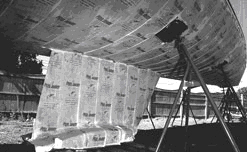New York Sea Grant's
Marina Pollution Prevention Web Site
Section 2: Painting
& Fiberglass Repair
- Paint Stripping
"Environmentally-Sensitive" Chemical Paint Strippers
Chemical paint strippers can actually eliminate paint chips and
dust associated with sanding, scraping and blasting. There are
now less toxic and less hazardous alternatives to strippers that
use methylene chloride and other organic solvents. New products
are non-chlorinated, biodegradable, have low volatility and are
not listed as hazardous. Some of the more environmentally-sensitive
strippers may be water based and use less toxic materials (look
for dibastic esters, semi-aqueous terpene-based products, detergents
and C9 to C12-based hydrocarbon strippers). While the new strippers
themselves may be considered non-hazardous, metals and chemicals
from the paint they remove may be hazardous, so all residue and
wash water must be collected and disposed of properly.

Chemical paint stripper and covering cloth applied
to boat hull
Planning Considerations
Environmentally-sensitive paint strippers are usually made without
toxic or caustic chemicals, so they do not burn skin and will
not release harmful fumes like some of the more aggressive chemical
strippers. This can reduce or eliminate the need for special ventilation
equipment.
The more environmentally-friendly strippers may require more experience
and expertise to apply correctly, as well as more time to work
effectively. Some may have to remain on the hull for 2 to 24 hours
depending on the condition of the hull and air temperature. Lower
temperatures require longer times, and some products do not work
well below 32°F.
When stripping, place plastic around and under the work area to
catch any drips. Some products come with a special paper placed
over the stripper after it has been applied that helps contain
the chemicals and dissolved paint.
Strippers may not work on all paints, such as 2-part epoxies or
chlorinated rubbers. Check with the manufacturer for specific
applications.
Machine used to pressure wash and collect washwater in one step
from chemically stripped hull.
Stripping residue and washdown water may be contaminated by paint
and must be collected and disposed of properly, possibly as a
hazardous waste. Special machines that pressure wash the hull
and collect the washwater in a one-step process are available
for this purpose. It is estimated that a 30-foot boat would generate
approximately 30 gallons of waste, including washdown water.
Cost
Costs will vary depending on product used, conditions, and layers
of paint to be removed. Non-toxic, water-based strippers can cost
$40 to $60 per gallon. According to one manufacturer, a gallon
of their product will cover an average of 50 square feet of hull
so the estimated cost of materials is one dollar per square foot.
A 30-foot boat may require five to six gallons. The manufacturer
also estimated disposal cost for the residue to be about $30 per
boat depending on size. Complete pressure washing/vacuum collection
systems cost $5,000 but costs can be reduced if the marina has
an existing pressure washer and/or vacuum system.

